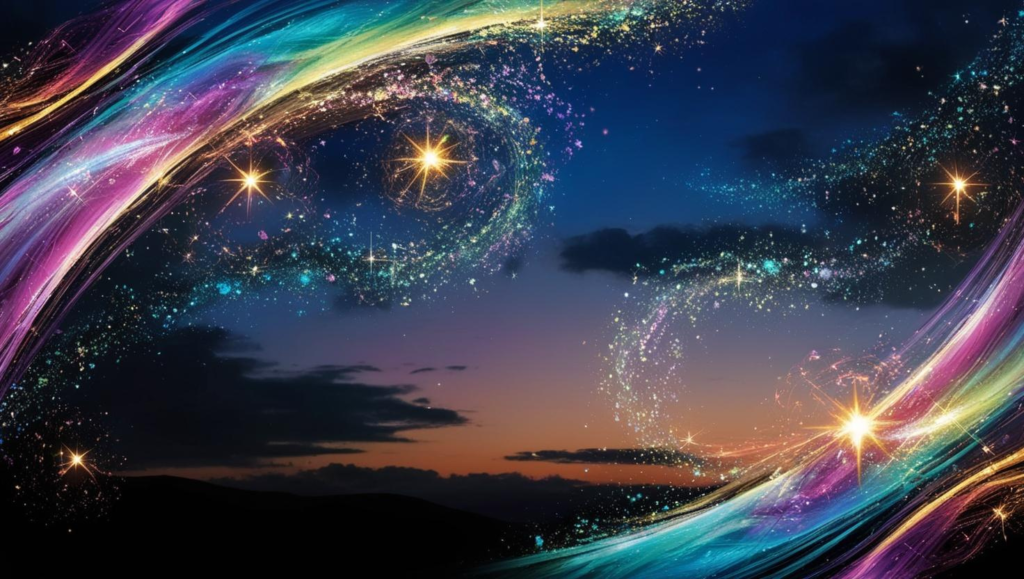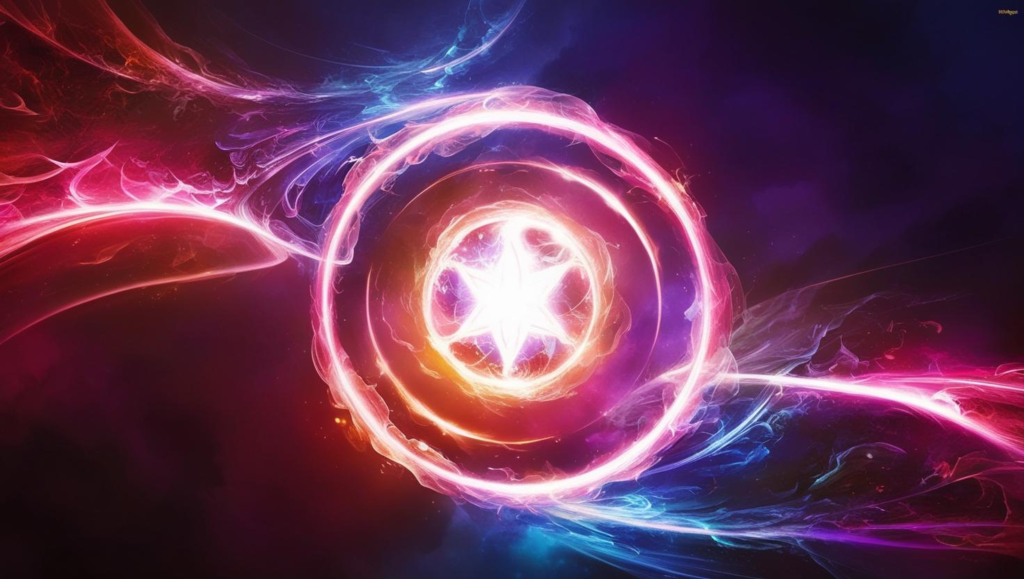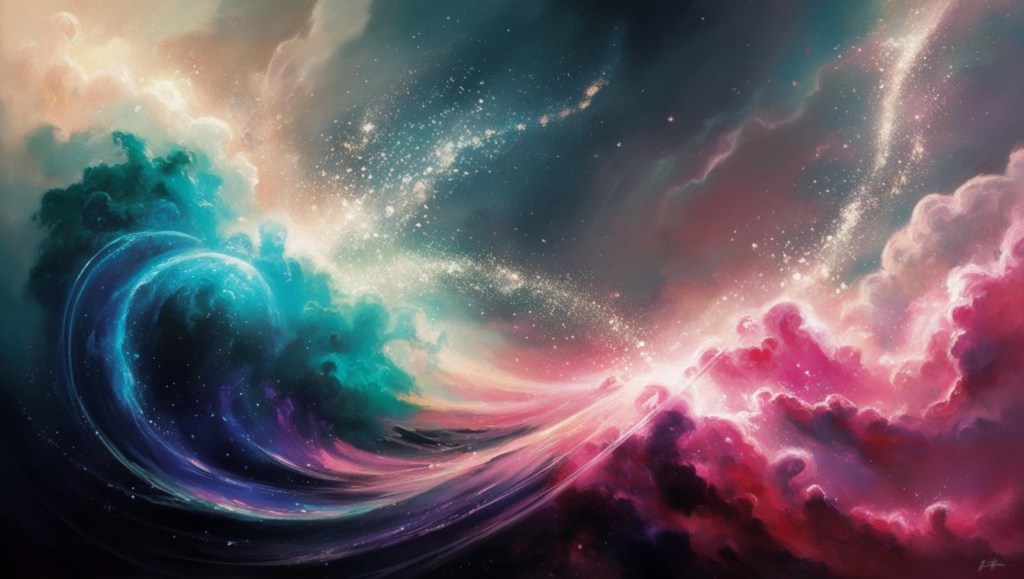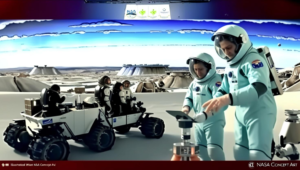Have you ever wonder ‘What is the color of space’?

What is the Color of Space?
Have you ever looked up at the night sky and wondered—what is the true color of space? At first glance, space appears black, vast, and empty. But is it really just black, or is there more to it?
क्या आपने कभी रात के आसमान को देखकर सोचा है कि अंतरिक्ष का असली रंग क्या है? पहली नज़र में, अंतरिक्ष काला, विशाल और खाली दिखाई देता है। लेकिन क्या यह वास्तव में सिर्फ़ काला है या इसके अलावा और भी कुछ है?
Why Does Space Look Black?
Unlike Earth, where our atmosphere scatters sunlight to create blue skies, space has no atmosphere to scatter light. Since there is nothing for the light to bounce off, space appears black to our eyes. However, this does not mean space has no color at all.
पृथ्वी के विपरीत, जहाँ हमारा वायुमंडल सूर्य के प्रकाश को बिखेरकर नीला आकाश बनाता है, अंतरिक्ष में प्रकाश को बिखेरने के लिए कोई वायुमंडल नहीं है। चूँकि प्रकाश को परावर्तित करने के लिए कुछ भी नहीं है, इसलिए अंतरिक्ष हमारी आँखों को काला दिखाई देता है। हालाँकि, इसका मतलब यह नहीं है कि अंतरिक्ष का कोई रंग नहीं है।

The True Colors of Space
Space is filled with light from countless stars, galaxies, and nebulae, each emitting different colors. If we could see space beyond just what our eyes perceive, it would be a mixture of:
- Black – The absence of scattered light in most of space.
- Blue and White – The glow of stars, particularly young, hot stars.
- Red, Orange, and Yellow – Older stars and distant galaxies.
- Green and Purple – Light emitted from cosmic gases like hydrogen and oxygen.
अंतरिक्ष अनगिनत तारों, आकाशगंगाओं और नीहारिकाओं से निकलने वाले प्रकाश से भरा हुआ है, जिनमें से प्रत्येक अलग-अलग रंग उत्सर्जित करता है। अगर हम अंतरिक्ष को सिर्फ़ अपनी आँखों से देखे जाने वाले प्रकाश से परे देख पाते, तो यह इन चीज़ों का मिश्रण होता:
- काला – अंतरिक्ष के अधिकांश भाग में बिखरे हुए प्रकाश की अनुपस्थिति।
- नीला और सफ़ेद – तारों की चमक, विशेष रूप से युवा, गर्म तारे।
- लाल, नारंगी और पीला – पुराने तारे और दूर की आकाशगंगाएँ।
- हरा और बैंगनी – हाइड्रोजन और ऑक्सीजन जैसी ब्रह्मांडीय गैसों से निकलने वाला प्रकाश।
The Cosmic Latte: The Average Color of the Universe
Scientists have actually determined the “average” color of the universe! In 2002, astronomers Karl Glazebrook and Ivan Baldry analyzed the light from thousands of galaxies and concluded that the universe’s average color is a pale beige, which they named “Cosmic Latte.”
वैज्ञानिकों ने वास्तव में ब्रह्मांड का “औसत” रंग निर्धारित कर लिया है! 2002 में, खगोलशास्त्री कार्ल ग्लेज़ब्रुक और इवान बाल्ड्री ने हज़ारों आकाशगंगाओं से आने वाले प्रकाश का विश्लेषण किया और निष्कर्ष निकाला कि ब्रह्मांड का औसत रंग हल्का बेज है, जिसे उन्होंने “कॉस्मिक लैटे” नाम दिया।

The Beauty of Space Beyond Black
Even though space looks black to our eyes, powerful telescopes like Hubble and James Webb capture its hidden beauty—colorful nebulae, glowing galaxies, and stunning star clusters. These colors, often invisible to the naked eye, reveal the breathtaking diversity of the cosmos.
भले ही अंतरिक्ष हमारी आँखों को काला दिखाई देता है, लेकिन हबल और जेम्स वेब जैसे शक्तिशाली दूरबीनों ने इसकी छिपी हुई खूबसूरती को कैद कर लिया है – रंगीन नीहारिकाएँ, चमकती हुई आकाशगंगाएँ और आश्चर्यजनक तारा समूह। ये रंग, जो अक्सर नंगी आँखों से अदृश्य होते हैं, ब्रह्मांड की लुभावनी विविधता को प्रकट करते हैं।
The Colors of the Cosmos: Exploring the Palette of Space
When we gaze up at the night sky, we are met with a canvas of deep black sprinkled with the twinkling light of distant stars. But space is far from monochromatic. Hidden within the darkness lies a vibrant spectrum of colors, waiting to be revealed by the discerning eye of telescopes and scientific instruments.
जब हम रात के समय आसमान की ओर देखते हैं, तो हमें गहरे काले रंग का कैनवास दिखाई देता है, जिस पर दूर के तारों की टिमटिमाती रोशनी बिखरी होती है। लेकिन अंतरिक्ष एक रंग से बहुत दूर है। अंधेरे के भीतर रंगों का एक जीवंत स्पेक्ट्रम छिपा है, जो दूरबीनों और वैज्ञानिक उपकरणों की समझदार आँखों द्वारा प्रकट होने का इंतज़ार कर रहा है।
The Black of Space:
The blackness of space, often referred to as the “cosmic background,” is the result of the vast emptiness that exists between celestial objects. Unlike Earth’s atmosphere, which scatters sunlight and fills the sky with blue, space lacks the particles needed to reflect and scatter light. Therefore, light travels straight through, leaving the backdrop of the universe in deep, dark silence.
अंतरिक्ष का कालापन, जिसे अक्सर “ब्रह्मांडीय पृष्ठभूमि” कहा जाता है, आकाशीय पिंडों के बीच मौजूद विशाल खालीपन का परिणाम है। पृथ्वी के वायुमंडल के विपरीत, जो सूर्य के प्रकाश को बिखेरता है और आकाश को नीले रंग से भर देता है, अंतरिक्ष में प्रकाश को परावर्तित करने और बिखेरने के लिए आवश्यक कणों की कमी है। इसलिए, प्रकाश सीधे यात्रा करता है, जिससे ब्रह्मांड की पृष्ठभूमि गहरे, अंधेरे सन्नाटे में रह जाती है।
Stars: A Spectrum of Stellar Hues:
While appearing as white pinpricks to the naked eye, stars emit a range of colors determined by their temperature.
- Red Stars: These are the coolest stars, with surface temperatures around 3,000 degrees Celsius.
- Orange Stars: Slightly hotter than red stars.
- Yellow Stars: Our Sun is a yellow dwarf star, with a surface temperature of approximately 5,500 degrees Celsius.
- White Stars: These stars are hotter than yellow stars.
- Blue Stars: The hottest stars, with surface temperatures exceeding 25,000 degrees Celsius.
नंगी आँखों से सफ़ेद रंग के छोटे-छोटे निशानों की तरह दिखने वाले तारे अपने तापमान के आधार पर कई तरह के रंग उत्सर्जित करते हैं।
- लाल तारे: ये सबसे ठंडे तारे हैं, जिनकी सतह का तापमान लगभग 3,000 डिग्री सेल्सियस होता है।
- नारंगी तारे: लाल तारों से थोड़े ज़्यादा गर्म।
- पीले तारे: हमारा सूर्य एक पीला बौना तारा है, जिसकी सतह का तापमान लगभग 5,500 डिग्री सेल्सियस होता है।
- सफ़ेद तारे: ये तारे पीले तारों से ज़्यादा गर्म होते हैं।
- नीले तारे: सबसे गर्म तारे, जिनकी सतह का तापमान 25,000 डिग्री सेल्सियस से ज़्यादा होता है।
Nebulae: Cosmic Clouds of Color:

Nebulae are interstellar clouds of gas and dust, and they are some of the most colorful objects in the universe. Their vibrant hues are a result of:
- Emission Nebulae: These nebulae glow due to the ionization of gases by nearby hot stars, emitting characteristic colors like red (hydrogen) and green (oxygen).
- Reflection Nebulae: These nebulae reflect the light of nearby stars, appearing blue due to the scattering of starlight by dust particles.
- Dark Nebulae: These nebulae are dense clouds of dust that block the light of objects behind them, appearing as dark patches against a brighter background.
नेबुला गैस और धूल के अंतरतारकीय बादल हैं, और वे ब्रह्मांड में सबसे रंगीन वस्तुओं में से कुछ हैं। उनके जीवंत रंग निम्नलिखित का परिणाम हैं:
- उत्सर्जन नेबुला: ये नेबुला पास के गर्म तारों द्वारा गैसों के आयनीकरण के कारण चमकते हैं, लाल (हाइड्रोजन) और हरा (ऑक्सीजन) जैसे विशिष्ट रंगों का उत्सर्जन करते हैं।
- परावर्तन नेबुला: ये नेबुला पास के तारों के प्रकाश को परावर्तित करते हैं, धूल के कणों द्वारा तारों के प्रकाश के बिखराव के कारण नीले दिखाई देते हैं।
- डार्क नेबुला: ये नेबुला धूल के घने बादल हैं जो अपने पीछे की वस्तुओं के प्रकाश को अवरुद्ध करते हैं, एक उज्जवल पृष्ठभूमि के खिलाफ काले धब्बों के रूप में दिखाई देते हैं।
Galaxies: Swirls of Color:
Galaxies, vast collections of stars, gas, and dust, exhibit a variety of colors depending on their composition and age.
- Spiral Galaxies: These galaxies often display a bluish tint in their spiral arms, where young, hot stars are forming, and a yellowish hue in their central bulge, where older stars reside.
- Elliptical Galaxies: These galaxies typically appear yellowish-red, as they contain mostly older, redder stars.
आकाशगंगाएँ, सितारों, गैस और धूल का विशाल संग्रह, उनकी संरचना और उम्र के आधार पर विभिन्न रंगों का प्रदर्शन करती हैं।
सर्पिल आकाशगंगाएँ: ये आकाशगंगाएँ अक्सर अपनी सर्पिल भुजाओं में एक नीला रंग दिखाती हैं, जहाँ युवा, गर्म तारे बन रहे हैं, और उनके केंद्रीय उभार में एक पीला रंग, जहाँ पुराने तारे रहते हैं।
अण्डाकार आकाशगंगाएँ: ये आकाशगंगाएँ आमतौर पर पीले-लाल रंग की दिखाई देती हैं, क्योंकि इनमें ज़्यादातर पुराने, लाल तारे होते हैं।
The Role of Technology:
Our understanding of the colors of space has been greatly enhanced by advances in technology. Telescopes like the Hubble Space Telescope can capture images of faint and distant objects, revealing the hidden beauty of the cosmos. Furthermore, scientific instruments can analyze the light emitted by celestial objects, allowing astronomers to determine their composition, temperature, and motion.
प्रौद्योगिकी में प्रगति के कारण अंतरिक्ष के रंगों के बारे में हमारी समझ में बहुत वृद्धि हुई है। हबल स्पेस टेलीस्कोप जैसे टेलीस्कोप धुंधली और दूर की वस्तुओं की तस्वीरें ले सकते हैं, जिससे ब्रह्मांड की छिपी हुई सुंदरता का पता चलता है। इसके अलावा, वैज्ञानिक उपकरण आकाशीय पिंडों द्वारा उत्सर्जित प्रकाश का विश्लेषण कर सकते हैं, जिससे खगोलविदों को उनकी संरचना, तापमान और गति का पता लगाने में मदद मिलती है।
The color of space is a complex and fascinating topic. It shows, that while space may seem dark, it is filled with many different types of colors.
अंतरिक्ष का रंग एक जटिल और आकर्षक विषय है। यह दर्शाता है कि अंतरिक्ष भले ही अंधकारमय लगता हो, लेकिन यह कई अलग-अलग प्रकार के रंगों से भरा हुआ है।
So next time you gaze at the night sky, remember—space is not just black. It is a vast, colorful masterpiece, waiting to be explored!
तो अगली बार जब आप रात के आसमान को देखें, तो याद रखें—अंतरिक्ष सिर्फ़ काला नहीं है। यह एक विशाल, रंगीन कृति है, जिसका अन्वेषण किया जाना बाकी है! 🚀✨🚀✨



